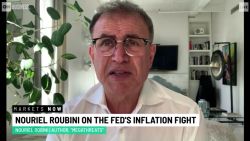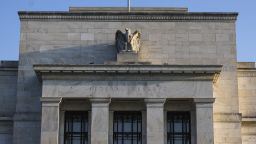Consumers may be worried about inflation and rising interest rates. But don’t tell that to Wall Street.
Stocks rose again Tuesday. It was a third-straight day of gains in what’s turning out to be a very bullish October. The Dow rose nearly 340 points, or 1.1%. The blue chips have now surged about 11% so far this month.
The S&P 500 and Nasdaq also moved higher Tuesday, rising 1.6% and 2.3% respectively.
So why is the market in rally mode even though consumers are worried about the rising price of just about everything? There are two key reasons.
For one, earnings are still pretty good. GM (GM), Coca-Cola (KO) and UPS (UPS) were a few of the iconic American companies to report strong profits and sales for the third quarter on Tuesday. So even though consumers and businesses may feel lousy every time they buy something and see how much it costs…they are still spending.
Until sagging consumer confidence and high inflation actually hurt demand, then corporate profits…and therefore stocks…may hold up.
There’s another factor at play, too, and one that’s a little more counterintuitive. The relentless drumbeat of scary economic news — housing slowdown headlines, inflation fears, geopolitical worries and recession jitters — may lead the Federal Reserve to pull back on its pace of interest rate hikes.
Investors are hoping that’s true because they are worried that overly aggressive rate increases by the central bank will send the economy into a deep and prolonged recession.
Don’t forget: Markets are forward looking
The Fed has raised rates by three-quarters of a percentage point at each of its last three meetings in its battle against inflation, and the central bank is widely expected to do so again at its next meeting on Wednesday, Nov. 2. But after that, all bets are off.
And even though Wall Street expects the nation’s gross domestic product, the broadest measure of the economy, to have grown in the third quarter when the data is released on Thursday, recession alarm bells continue to ring.
The housing market is starting to pull back as mortgage rates have spiked. Manufacturing growth has slowed. CEOs are nervous about more regulations in Washington hurting growth. And rising energy prices could put a crimp in consumer demand.
That’s why there are growing hopes that, if the economy starts to show more signs of weakness AND inflation finally cools off a bit, the Fed may raise rates by only a half-point in December.
What’s more, the Fed could hit pause on raising rates further in 2023 as it waits to see what impact existing rate hikes are having on the economy. Some on Wall Street are even betting the Fed may reverse course and start cutting rates again later next year if it turns out the rate hikes went too far and sent the economy into recession.
It would appear that investors are playing the long game. Stocks have already plunged in 2022, in anticipation of the rising rate environment and a possible economic and earnings slowdown this year and in the first half of 2023.
But if the worst of the fallout from inflation and rate hikes is truly over by the second half of next year, then it makes sense for Wall Street to bet on that now. The famous saying about Wall Street is that markets are forward looking.
So even though consumers may be dwelling on what certainly looks like a gloomy economic environment currently, investors are already banking on (hopefully) happier times ahead in late 2023 and 2024.


























